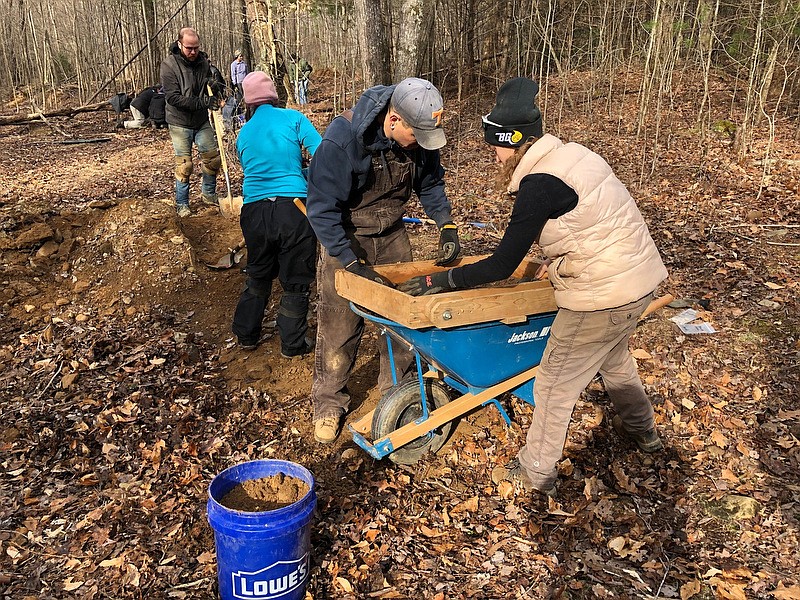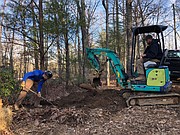COKER CREEK, Tenn. - The U.S. Forest Service has finished repairs on an estimated $2.4 million in damage the agency did to the Trail of Tears in Coker Creek, Tennessee, back in 2014 in a misguided attempt to discourage off-roaders and address erosion.
"We were scheduled to work through Friday," U.S. Forest Service Southern Region coordinator for the Trail of Tears Melissa Twaroski said early last week at the Coker Creek Welcome Center north of the repair project area, but organizers were "surprised by the enthusiasm of the volunteers" to do the work that began Jan. 29.
The trail segment that was repaired will remain closed to the public for three years while it recovers, she said.
Crews made up of Forest Service personnel, members from all three federally recognized area American Indian tribes - the Cherokee Nation, Eastern Band of Cherokee Indians and United Keetoowah Band of Cherokee - joined forces with Western Carolina University and Cherokee archaeologists in the restorative work that was completed Monday.
"From Jan. 7 until about the 24th we had an archeological crew from Western Carolina University doing some pre-work out there," Twaroski said. That project was led by archaeologist Dr. Brett Riggs, who has worked on the Trail of Tears for more than three decades.
The ensuing repair work involved removing the "tank trap" berms and "water bars" that were intended to block off-road vehicles, compacting soil into the dips and pits they left behind, installing erosion control blankets, staking straw bales and building a split rail fence. Native grass and plant seeds were sewn in work areas and the path itself was sewn with grasses durable enough to walk on.
While he's reluctant to say the repairs healed any wounds between the Cherokee and the federal government, Beau Carroll, an archaeologist and member of the Eastern Band of Cherokee Indians, said the repairs "went great, considering the situation that we were in and what occurred previously."
"I feel like the Forest Service did a good job in fixing what happened," Carroll said.
Carroll has been monitoring the site since Jan. 8, and was the tribal consultant and cultural specialist on any archeological finds during the work. He said there was not much found and that's good, because he'd rather objects stay put to preserve their integrity.
Most of what's in the roadbed goes back beyond the Cherokee Trail of Tears to cultures that existed thousands of years ago, he said. The Trail of Tears in Coker Creek traces a lot of the much older Unicoi Turnpike.
In this instance, federal officials were very sensitive to tribal concerns, Carroll said.
"Since this happened, they've always asked me how I felt and what I thought, and that goes a long way. You don't come across that very often," Carroll said of Cherokee relations with Forest Service officials. "It's usually people telling you how things are going to be, and it wasn't that way this time."
Tribes made some requests - for instance, a request was granted for tribal consultants to be on-site during the work - specific to this particular project, he said. One request from the tribe was to remove and relocate frog eggs found in some of the water-filled pits left behind by the tank trap and berm building. Twaroski and Carroll said hauling the frog eggs out of the woods in five-gallon buckets was some of the hardest work in the project.
Carroll praised volunteers who worked on the trail crew.
"I liked working with the volunteers because they made me feel like people other than me cared about what we were doing," he said. "They didn't have to be there. They weren't getting paid.
"The people really stood out to me," he said.
BACKGROUND
In 2014, the 461-acre tract containing the section of the Trail of Tears at issue was preserved in a joint effort by the Forest Service and the nonprofit organization The Conservation Fund. The protected trail also was intended to create connecting footpaths among nearby historic sites.
Land acquisition for the protected parcel began more than a decade before with the first tract that had identifiable segments of the Unicoi Turnpike/Trail of Tears roadbed, archives show. In 2009, the segment of the Unicoi Turnpike between Hayesville, North Carolina, and Athens, Tennessee, was made part of the official Trail of Tears.
A Forest Service timeline developed from its internal review obtained in 2016 by Public Employees for Environmental Responsibility indicates that conversations about work to stop erosion and block access to off-roaders began in January 2013.
From the timeline, it appears that a meeting on July 25, 2013, among forest service officials left some planners confused. The parcel had not yet been purchased for preservation.
"The district ranger and forest hydrologist left the meeting thinking that there were no cultural resource concerns, and that they had concurrence to move forward with the erosion stabilization work," the timeline states. "Both the forest archaeologist and the assistant forest archaeologist left the meeting unaware of any project work or project proposal being conceived and agreed upon within the Trail of Tears."
This point of miscommunication persisted into early 2014 as moves to acquire the land for preservation continued. The berm work was said by a forest hydrologist to be approved by the district ranger on Jan. 30, 2014, and the berm and "tank trap" work was performed from March 3-7, 2014, with several large "tank traps" being built a few weeks later at the TVA-gated entrance off of Joe Brown Highway.
The parcel of land containing the Trail of Tears subsequently was transferred to the Forest Service, and the trail damage was not discovered until a group participating in a stakeholders meeting on the Trail of Tears visited the site on July 14, 2015.
The Forest Service in September 2016 admitted to the damage, apologized and committed to repairs, with Southern Region U.S. Forest Service regional forester Tony Tooke saying the damage amounted to a "terrible error."
The service then began a long process of planning repairs that would satisfy tribal representatives and archaeologists, while drawing continuing criticism from some for taking so long.
IT TAKES TIME
Twaroski said there was a reason for the lengthy road to repairs, as 17 parties had to sign off on a memorandum of understanding on plans.
"Besides all the time it took to meet with the tribal representatives and other consulting parties and just listen to their anger, then genuinely apologize, and conduct all the assessments that were used to help guide the design of the trail remediation," Twaroski said, "the State Historic Preservation Office required us to take all of our findings of historical significance and supporting documentation for the damaged portion of the trail and the other archaeological sites we recorded within that tract of land to the Keeper of the National Register of Historic Places for a formal determination of significance" or eligibility for the National Register.
Forest Service officials and tribal representatives worked to develop the first draft of the repairs agreement that was then shared with the state Historic Preservation Office, Advisory Council on Historic Preservation, the National Park Service's National Trails Office, the National Trail of Tears Association and its chapter in Tennessee, and the Coker Creek Heritage Group, as well as others, Twaroski said in an email detailing negotiations.
"We took their input, added it to the document, shared it back with the tribal representatives and got their comments," she said. "When we had consensus, then our regional forester signed it (in October 2019), and the document went out for signatures."
Stakeholders in the matter took time as they considered the agreement.
"Some groups can sign these documents fairly quickly - however, for others, particularly the tribes, a document like this usually has to go before a committee, be reviewed by lawyers, and/ or go before the Tribal Council," Twaroski said. "For some tribes, they then have to pass a resolution permitting the chief or chairman to sign the document. Some tribal councils meet bi-weekly, some every other month - and the document/resolution has to get on the tribal council's agenda - so that took a while.
"We secured the last required signature on the legal agreement on Dec. 11, 2019," she said.
TIME TO HEAL
Over the next three years, the disturbed and restored soil on Coker Creek's portion of the Trail of Tears will begin to heal.
Twaroski, a 28-year veteran of the Forest Service, said she found the project "quite remarkable" and extended thanks to the people, groups and officials who worked so hard on it.
"Our executive leadership, our contracting and grants and agreements folks, as well as the tribes and our partners and volunteers, really pulled together to help make this happen," she said.
There could be healing in other ways, too.
Carroll said he has observed that when non-native archaeologists work directly with American Indians they gain a much deeper understanding of cultural issues.
While this particular interaction with the federal government was a positive experience, Carroll said there's still a major issue of trust between tribes and the federal government. He said the Trail of Tears repair project could serve as a model for future interactions.
"Hopefully, the way we did this project will carry forward to future projects," Carroll said.
Contact Ben Benton at bbenton@timesfreepress.com or 423-757-6569. Follow him on Twitter @BenBenton or at www.facebook.com/benbenton1.

